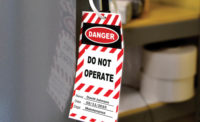The West Fertilizer plant explosion in Texas garnered a great deal of attention from ISHN.com visitors. Also on their reading list: temp worker safety, confined space tragedies and arc flash hazards. Here are the most-read Facility Safety stories of the year:
Blast at fertilizer plant devastates small Texas town
An explosion at a fertilizer plant in Texas last night powerful enough to cause a magnitude 2.1 earthquake has killed up to 15 people – and possibly more.
The casualty rate is expected to rise, according to press reports. A number of firefighters are among those still missing after the blast. (Firefighters – including volunteers – were at the plant fighting the blaze when the explosion occurred.) Two EMS personnel are confirmed dead.
The explosion occurred at the West Fertilizer Co. in West, Texas, a town of 2,700 residents about 20 miles north of Waco.
At least 160 people were injured. Sources at local hospitals said at least 38 people are listed in serious condition, in addition to nine burn victims who were…Read more>>
CSB: ATF destroyed, withheld fertilizer plant blast evidence
The U.S. Chemical Safety Board (CSB) says a turf war is hindering its investigation into the April 17 West, Texas fertilizer plant blast.
In a letter to Sen. Barbara Boxer (D-Cal.), CSB chairman Rafael Moure-Eraso accused the U.S. Bureau of Alcohol, Tobacco, Firearms and Explosives (ATF) of destroying and withholding evidence and refusing to permit CSB investigators access to the site.
Boxer chairs the Senate’s Environment and Public Works Committee, which plans to hold hearings on the explosion, which killed 15 and injured 200. It also destroyed or damaged dozens of buildings in West, a small, close-knit town north of Waco.
Referring to the ATF’s rationale for its handling of the situation, Moure-Eraso said the tight controls were unwarranted. “All indications are that the event was an industrial accident” – not criminal activity, as initially suspected by the ATF.
Moure-Eraso said the ATF had destroyed vital evidence by using cranes, bulldozers and other large equipment to sift through debris “in an ultimately unsuccessful quest to find…” Read more>>
Confined space tragedies continue to occur
This year, as in the past, we’ve read several unfortunate headlines about workers being killed on the job, often in permit-required confined spaces. For instance, seven workers were killed performing maintenance work at a brewery owned by the makers of Corona beer. The cruise ship “MS Pacific,” better known as the “Love Boat” from the television series and sold to scrap this year, claimed the lives of two workers and poisoned eight others while they pumped water from the ship’s engine room. These recent incidents indicate that, given everything we know about the dangers of confined spaces, workers are still entering them to perform work and are placing their lives at risk by not following established safety standards and failing to maintain continuous air quality monitoring. Although the two mentioned tragic incidents occurred outside of the United States, confined spaces can be deadly in any part of the world.
Staying safe
Specific to the U.S., the standard to follow for confined space work is OSHA 29 CFR 1910.46. This standard defines a confined space and permit-required confined space. A confined space possesses the following attributes:…Read more>>
What fall protection is required for scissor lifts?
In response to a letter requesting compliance assistance concerning the use of seat belts on powered industrial trucks and the use of fall protection on scissors lifts, OSHA formally stated:
National consensus standard ASME B56.1-1993, Safety Standard for Low Lift and High Lift Trucks, requires manufacturers to provide, and operators to wear operator restraint systems.
OSHA does not currently have a specific standard requiring the use of an operator restraint system.
However, the use of operator restraint systems is enforced through Section 5(a)(1) of the Occupational Safety and Health Act, which requires that each employer furnish to each of his employees employment and a place of employment which are free from recognized hazards that are causing or likely to cause death or serious physical harm to his employees.
In addition, the proposed revision to the powered industrial truck operator training standard requires employers to…Read more>>
Officials now know what exploded at Texas fertilizer plant – but not why
Sources say an investigation into the fatal April 17 blast at a West, Texas fertilizer plant has already yielded some information, though it’s expected to continue beyond this week.
The Texas State Fire Marshal’s Office has identified ammonium nitrate – a relatively inexpensive fertilizer with a high nitrogen content – as the substance that caused the explosion, killing 14 people and injuring approximately 200 more. Dozens of buildings near the site were destroyed or damaged.
A spokesman for the office said that in addition to that finding, investigators have been able to determine that the blast originated in the fertilizer and seed building – but not why it occurred. An ignition source has not yet been discovered.
In addition to its use as a fertilizer, ammonium nitrate is a component in a popular explosive. It was used as an ingredient in the Oklahoma City bombing in 1995 that left 168 people dead – one reason why facilities who store it in certain quantities are required to…Read more>>
21-year-old temp worker dies on his first day on the job
OSHA has cited Bacardi Bottling Corp. with 12 alleged safety violations following the death of a 21-year-old temporary worker his first day on the job. Lawrence Daquan "Day" Davis was crushed to death by a palletizer machine at the Jacksonville facility in August 2012. The company uses Remedy Intelligent Staffing as a temporary staffing service to provide laborers for certain types of jobs.
Davis was cleaning glass from under the hoist of a palletizing machine when an employee restarted the palletizer. Bacardi Bottling had failed to train temporary employees on utilizing locks and tags to prevent the accidental start-up of machines and to ensure its own employees utilized procedures to lock or tag out machines.
Two willful citations have been issued for failing to develop, document and utilize lockout/tagout procedures for the control of potentially hazardous energy and train temporary workers on lockout/tagout procedures.
"We are seeing untrained workers – many of them temporary workers – killed very soon after…” Read more>>
Portable heating solutions for worker safety and comfort
There are a number of portable heating options available today for industrial applications.
Start by defining what you hope to achieve with portable heating. Keeping workers warm for their health, comfort and productivity should be the paramount goal, but there may be other considerations too. Do you need to deliver heating to a process that requires a certain minimum temperature level? Are you trying to keep pipes from freezing and bursting? Are you looking to deliver nighttime or weekend heating to a specific area when the main plant is shut down? These considerations might impact the type of heating you will need and where it should be placed.
Does your facility have a combustible dust issue? Some portable heaters use open flames, which could ignite explosive dust particles — so in these instances, a 100-percent clean, safe, flame-free heat source will be required. What is the best type? If it utilizes gas, where will the gas come from?
What is the net heating effect that will be required? Even if you know the general cfm requirement, the local climate and desired temperature will impact…Read more>>
Worker without FR clothing dies in flash fire
A natural gas company’s failure to provide a worker with FR clothing led to a fatality, according to OSHA, which has cited Pennsylvania-based J.R. Resources for eight safety and health violations.
The employee died from injuries sustained during a flash fire.
The company’s seven serious violations include failing to…Read more>>


